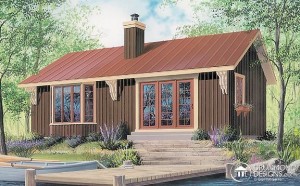Last month I received an email from a very ambitious soul in Sooke, BC asking if we had ever considered turning some of our shed designs into home plans. At first I thought she meant using the style as the basis for a home design or a Carriage House Plan, but after a number of emails and phone calls her mission was clear – tiny, tiny, tiny (tiny house plans)! Lois turned out to be a wonderful person and a really creative thinker. She wanted to embrace the idea of adding multiple dwellings on her Sooke property in accordance with new zoning which allowed for densification.
The idea of micro-living intrigued me so it was time for some research.
After much digging on the web and calling different city halls around BC, I came to understand that Lois’ idea is more than just a concept – it is now a reality. Many regions are allowing additional dwellings to be added to properties as separate living units for grandparents, renters, and the increasingly common “boomerang children”. These dwellings are sized in accordance with local building by-laws and can be as small as 300 square feet which is, amazingly, in accordance with the National Building code of Canada. Formalizing densification also addresses the issue that there were illegal (and often unsafe) dwellings being added to properties.

Still the question begs to be asked, “Why would someone want to build (or live in) a home the size of a shed?” From a user’s point of view, a tiny house would be perfect for someone needing independence, low maintenance, affordability, and safety. From a city planner’s perspective, it addresses affordable housing and densification mandates. From a landlords perspective it’s a small space to independently house a family member or generate income to help out with mortgage payments. From city hall’s perspective it is additional tax revenue. When you look at it from all of these perspectives, tiny houses make sense.
Can a person comfortably live in a space so small? One need only ask people with live-aboard boats and RV’s that very question. With careful planning and paring down to necessities, both groups of people would say “absolutely”! Of course, it may be quite challenging for a young or growing family but “living small” is an ecological and social challenge that some are happy to embrace.
For the purpose of definition, Drummond House Plans classifies a tiny house as a dwelling which is under 1100 square feet. These houses are frequently fawned over as being darned cute and amazingly efficient. These homes also have the added benefit of having a smaller carbon footprint and are ideal for areas which embrace high-density housing.
Thank you, Lois, for starting this conversation. We look forward to adding more designs to our available Drummond Tiny House Plans for people just like you.

I have to say that I have a friend that lives in a “micro Home” were she has a small living area, little kitchen (I mean little can’t swing a cat in there) and a separate bedroom/bathroom, and it really is very cosy for her, and she loves it as a single person, even though she still entertains her friends in the little garden, she can also just lock up and go.
There are many people that are looking for places like these, as they are economical and almost maintainace free, and everyone seems to be in a win win situation.
The concept of micro-living makes a lot of sense in developing countries, where shack dwellers commonly have families of up to 12 people living in a single room! Us western folks are very blessed with space, and downsizing to save money on everything from rent to energy expenditure really does make sense.
I’m not saying 12 people to one room, but better utilisation of space really makes good green sense, and I’d really like to see more smaller designs.
Fantastic! The City of Courtenay has all ducks in a nice row ready for buildings like this in some areas. Now home owners need a “little” inspiration… this is great!
b
Great article, Richard, and I’m so impressed at your interest in the concept. It’s very affirming to have a genuine human response when sending an email to a big company. Not to be picky(but doing it anyway, heheheh) the definition of “Tiny House” usually means something UNDER 600 sf , for the purists it would be a fraction of that.. For general application, a tiny house should be “barely code” as you say maybe 300-400. These days those from 600 to 1100 are “small” houses, even if they are the size our grandparents raised their families in. Living in 210 sf as I do presently, I consider 1100 sf neither tiny nor small, but a regular mini-Mansion. I sincerely hope that Drummond will not let this idea stall, but will ask a couple of your most skilled designers to “make it work” in 400 sqft, or less, just to prove how good they are. I would so love to see the results on your website, and I suspect it would put you out in front of the curve in the internet market.L>
Great Post! This kinda home would be perfect for me. I need peace and not to much space. People with no kids could easily live in this kinda home.
Thanks!!!